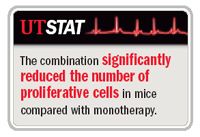Article
Addition of novel prostate cancer agent to taxane shows benefit
Atlanta-Combining the endothelin A (ETA) receptor antagonist atrasentan (Xinlay) with taxane chemotherapy has a significant additive effect against prostate cancer, results of a preclinical investigation presented at the AUA annual meeting here have demonstrated.

Treatment with atrasentan, which is investigational, plus paclitaxel (Abraxane, Taxol) or docetaxel (Taxotere) significantly decreased cell viability and increased apoptosis (programmed cell death) compared with a cytotoxic agent or atrasentan alone. Similarly, prostate cancer xenografts exhibited lower tumor volumes and growth rates with combination treatment than with monotherapy.
"We thought that atrasentan might have a niche when used in combination with FDA-approved drugs to treat prostate cancer," said Ardavan Akhavan, a medical student at the University of Pittsburgh working with Joel B. Nelson, MD, and Beth R. Pflug, PhD. "Atrasentan and these drugs have non-overlapping mechanisms of action, so we thought the combination might produce an additive effect against prostate cancer."

Decrease in cell population
Using a mouse model, investigators compared the effects of monotherapy with atrasentan, docetaxel, and paclitaxel with the combination of atrasentan and docetaxel or paclitaxel in the PPC-1 prostate cancer cell line, an aggressive cancer cell. Additionally, mice implanted with PPC-1 xenografts were treated for 21 days with monotherapy or the combination of atrasentan and docetaxel. Apoptosis, cell proliferation, and tumor vascularization were determined by in situ TUNEL analysis, Ki67, and CD31 immunostaining.
Prostate cancer cells treated with the combination of atrasentan and doce-taxel/paclitaxel exhibited a significant decrease in the viable cell population and increased apoptosis compared with mono-therapy with either taxane or atrasentan (p<.05). The effect of combination therapy on cell death was dose dependent for the two taxanes. Combination treatment had a significant additive effect over monotherapy when atrasentan was combined with paclitaxel, 100 nM, but not a 10-nM dose of paclitaxel. In contrast, the combination of atrasentan and docetaxel, 10 nM, had a significant additive effect over monotherapy, but the combination with docetaxel, 100 nM, did not.
Mice treated with the combination of atrasentan and docetaxel had significantly reduced tumor volumes at 21 days compared with animals that received monotherapy (p=.0045). Mean tumor volume increased from 54.58 mm3 to 775.5 mm3 with atrasentan, 55.57 mm3 to 657.4 mm3 with docetaxel, and 55.1 mm3 to 321.7 mm3 with the atrasentan-docetaxel combination.
The combination also significantly reduced the number of proliferative cells in mice compared with monotherapy (p<.05). The combination did not affect tumor vascularity or serum levels of vascular endothelial growth factor compared with treatment with a single agent.
Co-administration of atrasentan and docetaxel did not lead to elevated tissue concentrations of the taxane, as determined by high-pressure liquid chromatography. Because of endothelin's vasoactive properties, consideration was given to the possibility that combination treatment could lead to increased tissue concentrations of the cytotoxic drug. The Pittsburgh group will continue to examine that possibility.
"We did a preliminary study looking at only one time point," Akhavan said. "We want to look at various time courses to see whether the drug concentration in-creases within the prostate."
A phase III clinical study of atrasentan-containing combination therapy with docetaxel is about to begin through the Southwest Oncology Group, he added.
Newsletter
Stay current with the latest urology news and practice-changing insights — sign up now for the essential updates every urologist needs.





